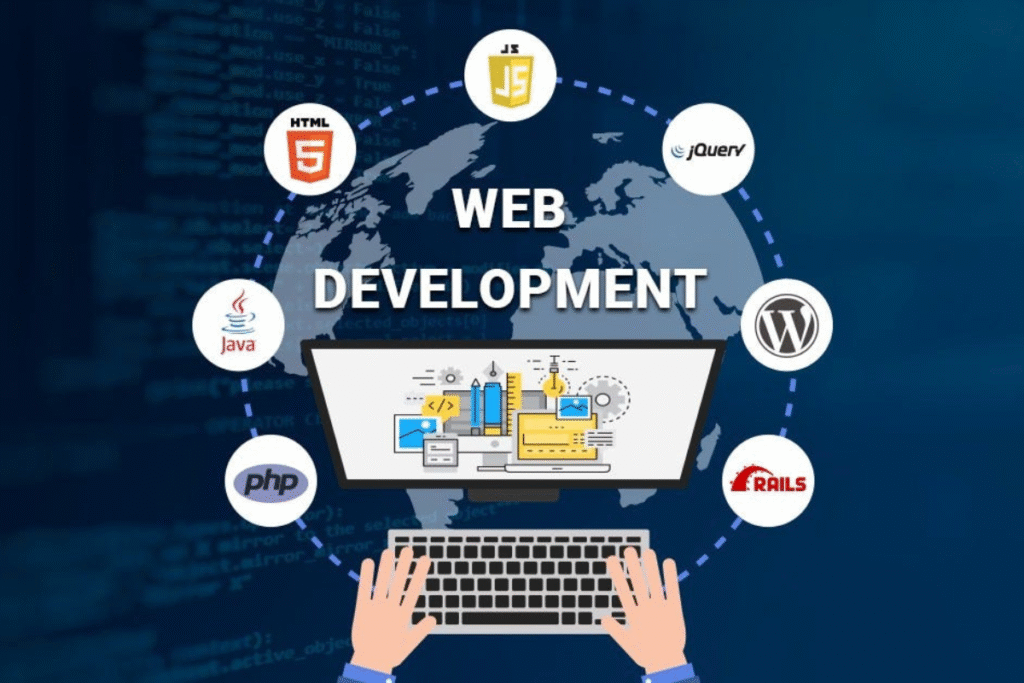Introduction
Web development is constantly evolving, and developers must stay ahead of the curve to create fast, secure, and user-friendly websites. Whether you’re a beginner learning the basics or a seasoned full-stack developer, the right tools and frameworks can make your workflow more efficient and effective.
In this blog, we’ll explore the Top 10 Tools and Frameworks shaping modern web development in 2025, their core features, and why they are essential for creating responsive, scalable, and future-ready web applications.
1. React.js – The Frontend Powerhouse
React.js, maintained by Meta (Facebook), is one of the most popular JavaScript libraries for building interactive user interfaces. It follows a component-based architecture, making it easy to develop reusable and scalable applications.
Basic Information Table
| Tool/Framework | Type | Key Features | Ideal For |
|---|---|---|---|
| React.js | JavaScript Library | Virtual DOM, Reusable Components, Fast Rendering | Frontend developers creating dynamic UIs |
| Angular | JavaScript Framework | Two-way Data Binding, MVC Structure, Dependency Injection | Enterprise-scale web applications |
| Vue.js | JavaScript Framework | Lightweight, Reactive Binding, Easy Learning Curve | Startups & rapid prototyping |
| Node.js | Runtime Environment | Event-driven, Non-blocking I/O, NPM ecosystem | Backend APIs & real-time applications |
| Django | Python Framework | Security-focused, Rapid Development, ORM | Full-stack developers & Python enthusiasts |
| Laravel | PHP Framework | MVC Architecture, Built-in Authentication, Blade Templates | Modern PHP web applications |
| Tailwind CSS | CSS Framework | Utility-first classes, Customizable Design System | Frontend developers needing fast styling |
| Bootstrap | CSS Framework | Pre-built Components, Grid System, Responsive Design | Quick web UI design |
| Next.js | React Framework | Server-Side Rendering (SSR), API Routes, SEO-Friendly | Scalable React applications |
| GitHub Copilot | AI Tool | Code Autocompletion, AI Suggestions, Multi-language Support | Developers improving coding efficiency |
2. Angular – The Complete Web Framework
Angular, developed by Google, is a TypeScript-based framework used for building dynamic web applications. It’s especially powerful for enterprise-level projects due to its two-way data binding, dependency injection, and modular development structure.
- Why Developers Love It: Strong community support, TypeScript integration, and robust performance.
- Best For: Large-scale projects like CRM systems, enterprise dashboards, and e-commerce platforms.
3. Vue.js – Lightweight and Flexible
Vue.js is known for its simplicity and ease of integration. It’s a progressive framework that allows developers to build applications quickly, especially when compared to heavier frameworks like Angular.
- Why Developers Love It: Lightweight, fast rendering, and flexibility.
- Best For: Startups, smaller teams, and rapid prototyping.
4. Node.js – The Backend Revolution
Node.js allows developers to build scalable backend applications using JavaScript. Its event-driven, non-blocking I/O model makes it a preferred choice for building real-time apps like chat applications and streaming services.
- Why Developers Love It: Single language for both frontend and backend, huge NPM ecosystem.
- Best For: APIs, chatbots, and real-time apps.
5. Django – Python’s Gift to Developers
Django is a high-level Python framework designed for clean and rapid development. It comes with built-in security features, an ORM (Object Relational Mapper), and scalability options.
- Why Developers Love It: Security-first approach, robust community, and “batteries-included” philosophy.
- Best For: Content-heavy sites, SaaS apps, and AI-based web solutions.
6. Laravel – PHP Made Modern
Laravel simplifies PHP development with its elegant syntax and MVC architecture. It provides features like Blade templating, built-in authentication, and database migration tools.
- Why Developers Love It: Easy routing, powerful ORM (Eloquent), and strong security features.
- Best For: PHP developers building modern, scalable web apps.
7. Tailwind CSS – Utility-First Styling
Tailwind CSS is a utility-first CSS framework that gives developers complete control over styling without writing custom CSS. It promotes reusability and speeds up design work.
- Why Developers Love It: Customizable, lightweight, and modern design system.
- Best For: Developers who want clean UI without relying heavily on pre-designed components.
8. Bootstrap – The Veteran of Web Design
Bootstrap remains one of the most widely used CSS frameworks, providing pre-built components and a responsive grid system.
- Why Developers Love It: Easy learning curve, great documentation, and wide community support.
- Best For: Quick prototypes and responsive layouts.
9. Next.js – The Future of React Applications
Next.js builds on top of React, offering server-side rendering (SSR), static site generation (SSG), and built-in API routes. It’s ideal for SEO-friendly web apps.
- Why Developers Love It: Performance optimization, image optimization, and hybrid rendering.
- Best For: Scalable React projects and SEO-driven websites.
10. GitHub Copilot – AI for Web Developers
GitHub Copilot, powered by OpenAI’s Codex, is an AI tool that helps developers write code faster by suggesting snippets, autocompleting functions, and even generating boilerplate code.
- Why Developers Love It: Speeds up development, reduces repetitive coding, and supports multiple languages.
- Best For: Developers who want AI assistance to boost productivity.
Conclusion
The web development world is expanding rapidly, and choosing the right tools and frameworks can drastically improve efficiency, scalability, and user experience.
From frontend powerhouses like React, Angular, and Vue to backend frameworks like Django and Laravel, and from design frameworks like Tailwind and Bootstrap to AI-driven tools like GitHub Copilot, developers now have a wide range of options.
If you’re a beginner, start with React.js or Vue.js for frontend and Node.js or Django for backend. For styling, Tailwind CSS is quickly becoming the preferred choice. And don’t forget to leverage AI tools like GitHub Copilot to stay competitive.
By keeping up with these technologies, you’ll not only stay relevant but also create innovative, high-performing applications that meet the demands of the modern digital world.

